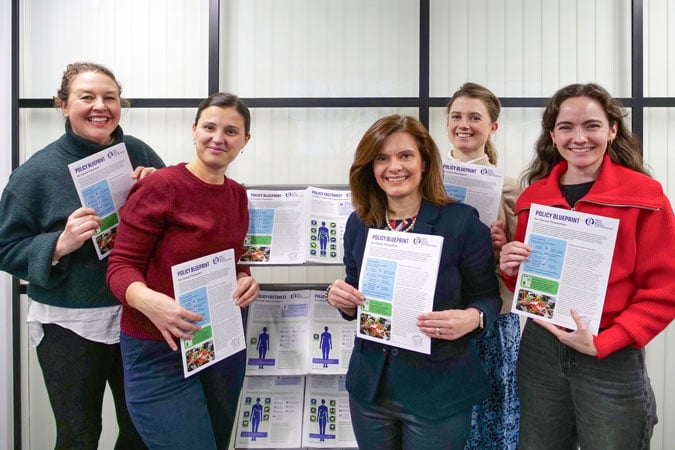Turning evidence into action: insights from our Policy Advisory Group

The World Cancer Research Fund International Policy Advisory Group (PAG) brings together leading policy experts from government, academia, and civil society around the world to guide WCRF’s efforts to turn evidence into action.
Established in 2015, the group advises on how to identify and communicate evidence effectively to policymakers and advance cancer prevention efforts. Its role is to highlight critical needs, overcome barriers to implementation, and strengthen alliances that can drive wider uptake of effective cancer prevention policies.
In this blog, we put a set of pressing global public health questions to the group, inviting them to share their insights on how best to steer policy and action in cancer prevention worldwide.
Elevating NCDs on the global agenda
NCDs have historically received less attention than infectious diseases, but PAG members agree that this is beginning to shift – albeit slowly. Dr Feisul Mustapha (Ministry of Health, Malaysia) notes that ageing populations, fiscal pressure, and post-COVID backlogs make NCDs unavoidable.
However, as Dr Si Thu Win Tin (Pacific Community, Fiji) observes, recognition has not translated into concrete action and funding investment to address NCDs, particularly in vulnerable regions such as Pacific small island developing states (SIDS).
Dr Henry Li (Tony Blair Institute for Global Change, UK) reframes the argument: NCDs are not a crisis but a structural economic challenge, threatening productivity, social stability, and fiscal sustainability.
All members agree that NCDs must be positioned beyond the health sector. Dr Feisul emphasises embedding NCDs into universal health coverage (UHC), climate policy, and development financing. Dr Win Tin calls for integration into health security and resilience agendas to unlock funding, while Dr Li highlights the need for life-course approaches to manage long-term costs.
Financing must pivot toward prevention, using measures such as earmarked taxes on tobacco, alcohol, and sugary drinks, subsidy reform, pooled procurement, and domestic co-financing, matched with catalytic international support.
Political will and sustainable delivery models are critical: prevention must be framed as essential to economic and social stability, not optional.
Policy interventions for maximum impact
When asked which interventions should be prioritised, the PAG highlighted both structural durability and innovation. Professor Shiriki Kumanyika (University of Pennsylvania, USA) reframes the question by considering what has shown least impact: behavioural interventions alone have a limited population-level effect in the absence of structural solutions.
Additionally, new pharmaceutical treatments like GLP-1s are changing policy expectations. Evidence is now needed on how these therapies can support primary and secondary cancer prevention while reinforcing dietary and nutrition policy measures.
Dr Li highlights structural policies – sugary drink taxes, marketing restrictions, and urban planning—not for maximum efficacy, but because they are politically durable and difficult to reverse. He also suggests pairing prevention with early detection technologies as a “Trojan horse” to attract investment and political momentum, ultimately benefiting longer-term preventive strategies. Collectively, these insights emphasise balancing innovation, feasibility, and sustainability in prevention policy.
The case for prevention
Prevention remains the most neglected pillar of cancer control, yet it is essential for sustainability. Dr Pubudu Sumanasekara (Movendi International, Sri Lanka) points out that prevention reduces demand on treatment services, empowers communities, and embeds healthier norms into daily life.
Michelle Halligan (Canadian Partnership Against Cancer, Canada) provides evidence from Canada: prevention is central to the national strategy because it reduces incidence and healthcare costs. Tobacco alone costs $16.2 billion annually, including $6.5 billion in direct healthcare costs. Prevention strategies – from supporting smoking cessation to promoting healthier lifestyles—save lives, reduce inequities, and protect public finances.
Dr Li adds a political lens: prevention is often unrewarding in the short term. Politicians prefer visible treatment projects, while prevention yields long-term gains. He recommends creating early wins, building unusual coalitions with employers, insurers, and urban planners, framing prevention as an economic opportunity, and leveraging health system crises to demonstrate that prevention is the only sustainable solution. Prevention must be reframed as an essential, politically relevant pillar of cancer control.
Equity in policy
Ensuring policies reach underserved populations is critical. Dr Feisul emphasises building equity into design from the outset: remove user fees, use disaggregated data, co-create with communities, and finance outreach.
In low- and middle-income countries, delivery models such as community health workers, mobile clinics, workplace hubs, HPV self-sampling, single-visit screen-and-treat programs, and patient support for travel and childcare are essential. Continuous monitoring and course-correcting ensure equitable coverage.
Halligan advocates proportionate universalism: combining universal access with targeted approaches ensures equity-denied populations are served while maintaining broad reach. Building trust and co-developing culturally safe services is essential. Professor Kumanyika suggests clarifying definitions of equity to guide concrete policy actions.
Dr Li cautions that rigid equity-first approaches can slow progress. Instead, he recommends designing universal programmes that can scale, then addressing gaps through adaptive, iterative policy interventions. Equity emerges most effectively from sustainable, abundant delivery systems rather than as a precondition that restricts innovation.
Partnerships for scale
Partnerships are vital to scaling cancer prevention. Dr Feisul identifies four priority collaborations:
- governments with civil society for accountability and last-mile delivery
- academia for research and implementation evaluation
- private sector actors for regulated co-delivery via logistics, workplaces, and digital tools
- and multilateral agencies and philanthropy for catalytic funding.
Dr Sumanasekara emphasises government coordination to align stakeholders, including media and private sector actors. Michelle Halligan highlights trust-based, reciprocal partnerships with communities historically excluded from decision-making (such as Indigenous peoples in Canada).
In the Pacific region, Dr Win Tin stresses the importance of regional organisations, communities, faith-based groups, and private-sector engagement. Professor Kumanyika adds that partnerships should link cancer prevention with human rights and environmental sustainability.
Dr Li warns that many partnerships fail because organisations optimise for their own visibility rather than shared outcomes. Successful partnerships create new delivery entities with shared risk, governance, and accountability, focusing on population-level outcomes. Examples include joint ventures between governments, tech companies, and payers, or employer–healthcare provider collaborations responsible for long-term employee health. Effective partnerships are about delivery, not coordination.
Under-recognised priorities
Several priorities remain under-recognised globally. Dr Sumanasekara identifies alcohol as a major neglected cancer risk factor: its social and economic costs are poorly researched, public awareness is low, and industry interference slows policy progress. Harm to others beyond individual users is especially overlooked, highlighting the need for communication strategies that change behaviour.
Dr Li points to systemic gaps: insufficient workforce for prevention, lack of implementation science, and inadequate interoperable data systems to coordinate care and target high-risk populations. Dr Win Tin notes that political and commercial pressures frequently block well-evidenced fiscal and regulatory interventions.
Dr Li emphasises that the disconnect is political rather than scientific: research must focus not only on what works, but on how to implement interventions successfully within complex political and institutional environments.
Underserved populations
PAG members highlight populations most overlooked in research. Dr Win Tin points to small island populations, indigenous communities, and remote rural areas, whose cultural, environmental, and dietary contexts are rarely studied, leaving policy misaligned with local realities.
Dr Li adds middle-income countries experiencing rapid urbanisation, where high-risk populations outpace health system capacity. He also notes populations outside traditional health system reach, including specific employment or demographic groups. Dr Li stresses that the central challenge is not evidence generation – World Cancer Research Fund and others already provide robust data – but translating it into politically sustainable and implementable policies that reach the populations who need them most.
Conclusion
Across these discussions, several consistent themes emerge.
- NCDs and cancer prevention are economic, social, and development imperatives, not optional health priorities.
- Prevention must be central, politically framed, and paired with structural interventions that endure. Equity should be embedded into delivery systems but approached pragmatically to avoid stifling innovation.
- Partnerships must move beyond coordination to create delivery-focused entities with shared accountability.
- Under-recognised risks such as alcohol, underserved populations, and implementation challenges demand greater attention.
- Finally, closing the gap between evidence and policy requires understanding political economy, incentivising prevention, and designing sustainable systems capable of delivering at scale.
Collectively, the PAG’s insights provide a roadmap for elevating cancer prevention and NCD policies globally: combine robust evidence with political strategy, innovate delivery, embed equity, and scale impact through partnerships aligned around outcomes rather than institutional interests.


